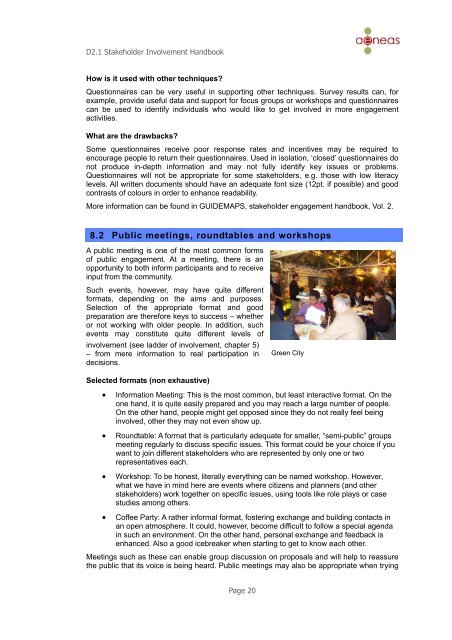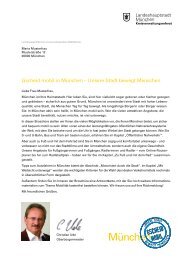D2.1 Stakeholder Involvement Handbook - AENEAS
D2.1 Stakeholder Involvement Handbook - AENEAS
D2.1 Stakeholder Involvement Handbook - AENEAS
Create successful ePaper yourself
Turn your PDF publications into a flip-book with our unique Google optimized e-Paper software.
<strong>D2.1</strong> <strong>Stakeholder</strong> <strong>Involvement</strong> <strong>Handbook</strong><br />
How is it used with other techniques?<br />
Questionnaires can be very useful in supporting other techniques. Survey results can, for<br />
example, provide useful data and support for focus groups or workshops and questionnaires<br />
can be used to identify individuals who would like to get involved in more engagement<br />
activities.<br />
What are the drawbacks?<br />
Some questionnaires receive poor response rates and incentives may be required to<br />
encourage people to return their questionnaires. Used in isolation, ‘closed’ questionnaires do<br />
not produce in-depth information and may not fully identify key issues or problems.<br />
Questionnaires will not be appropriate for some stakeholders, e.g. those with low literacy<br />
levels. All written documents should have an adequate font size (12pt. if possible) and good<br />
contrasts of colours in order to enhance readability.<br />
More information can be found in GUIDEMAPS, stakeholder engagement handbook, Vol. 2.<br />
8.2 Public meetings, roundtables and workshops<br />
A public meeting is one of the most common forms<br />
of public engagement. At a meeting, there is an<br />
opportunity to both inform participants and to receive<br />
input from the community.<br />
Such events, however, may have quite different<br />
formats, depending on the aims and purposes.<br />
Selection of the appropriate format and good<br />
preparation are therefore keys to success – whether<br />
or not working with older people. In addition, such<br />
events may constitute quite different levels of<br />
involvement (see ladder of involvement, chapter 5)<br />
– from mere information to real participation in<br />
decisions.<br />
Selected formats (non exhaustive)<br />
• Information Meeting: This is the most common, but least interactive format. On the<br />
one hand, it is quite easily prepared and you may reach a large number of people.<br />
On the other hand, people might get opposed since they do not really feel being<br />
involved, other they may not even show up.<br />
• Roundtable: A format that is particularly adequate for smaller, “semi-public” groups<br />
meeting regularly to discuss specific issues. This format could be your choice if you<br />
want to join different stakeholders who are represented by only one or two<br />
representatives each.<br />
• Workshop: To be honest, literally everything can be named workshop. However,<br />
what we have in mind here are events where citizens and planners (and other<br />
stakeholders) work together on specific issues, using tools like role plays or case<br />
studies among others.<br />
• Coffee Party: A rather informal format, fostering exchange and building contacts in<br />
an open atmosphere. It could, however, become difficult to follow a special agenda<br />
in such an environment. On the other hand, personal exchange and feedback is<br />
enhanced. Also a good icebreaker when starting to get to know each other.<br />
Meetings such as these can enable group discussion on proposals and will help to reassure<br />
the public that its voice is being heard. Public meetings may also be appropriate when trying<br />
Page 20<br />
Green City




